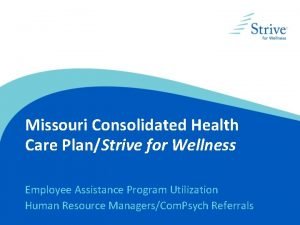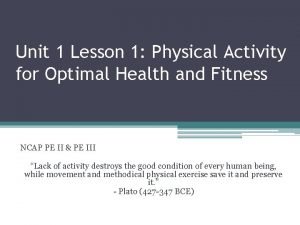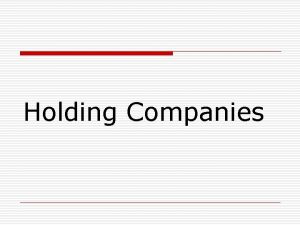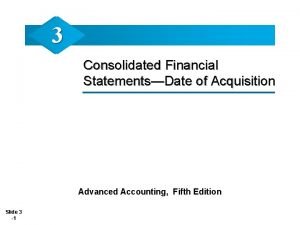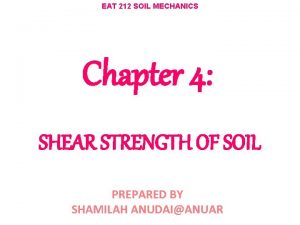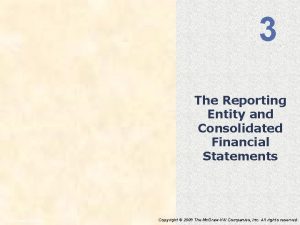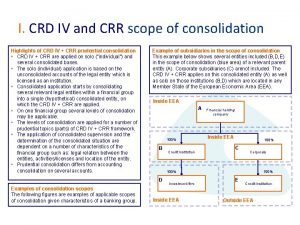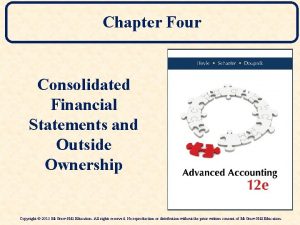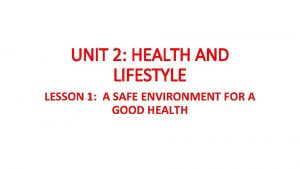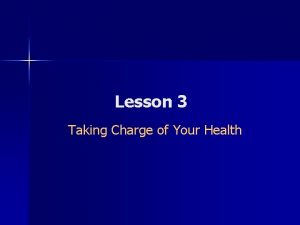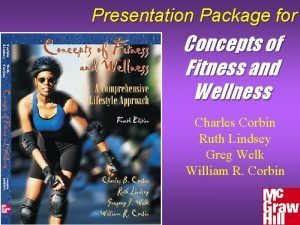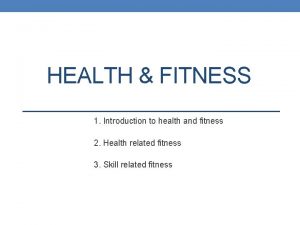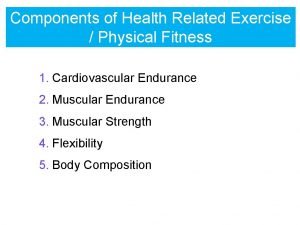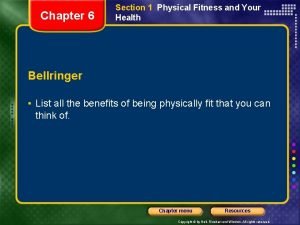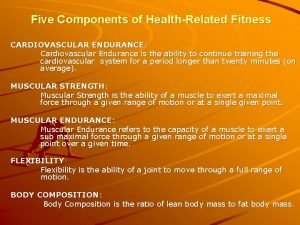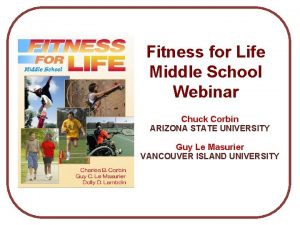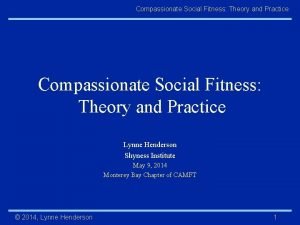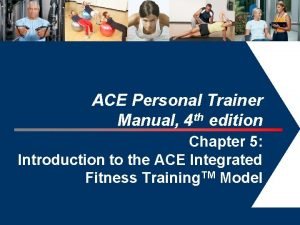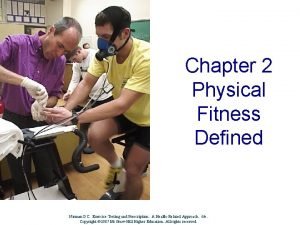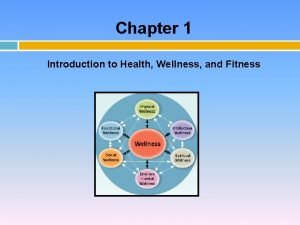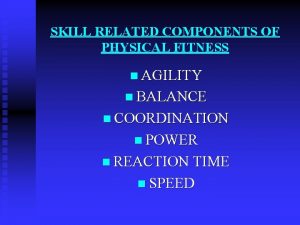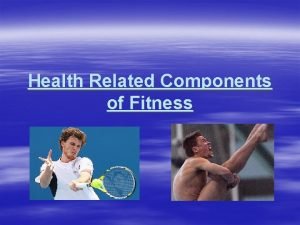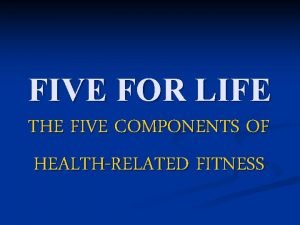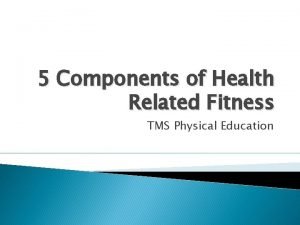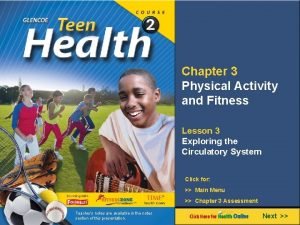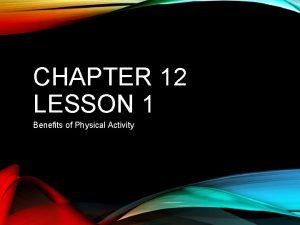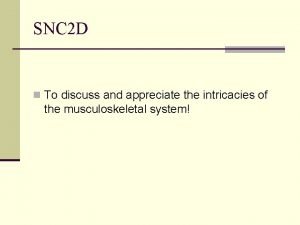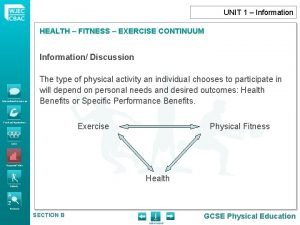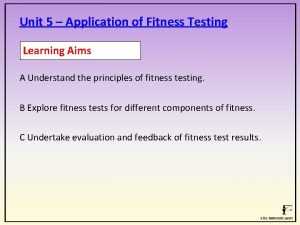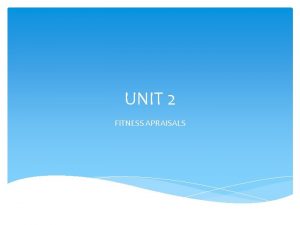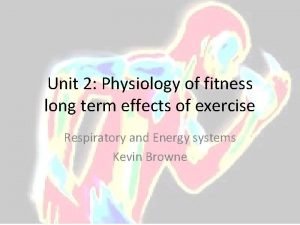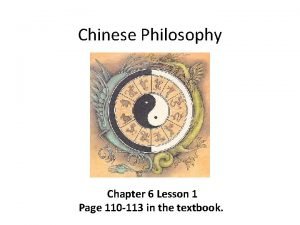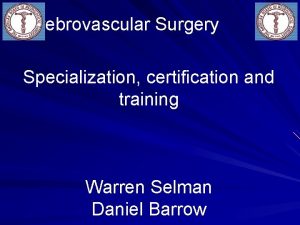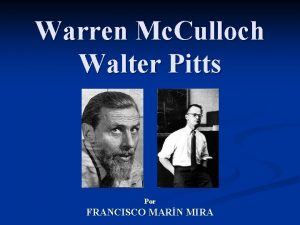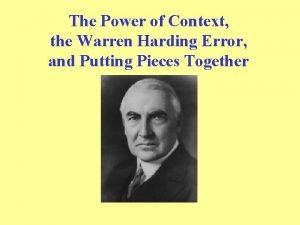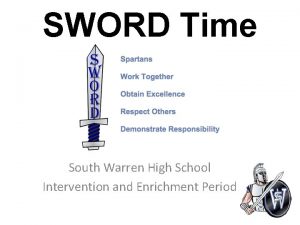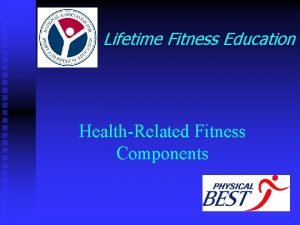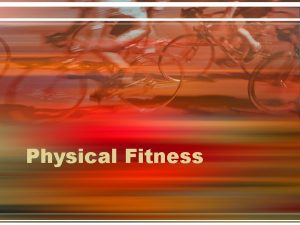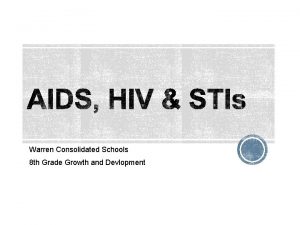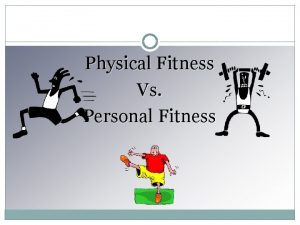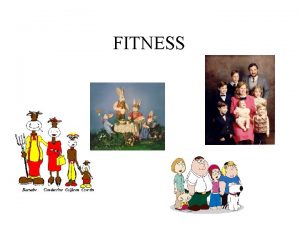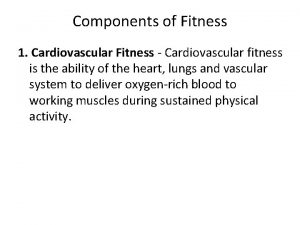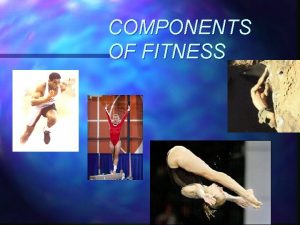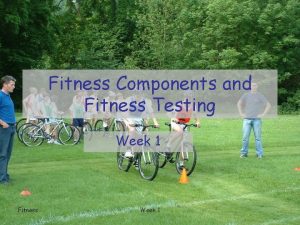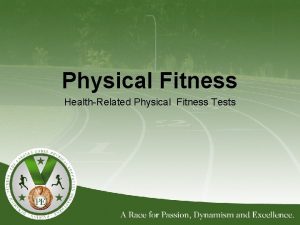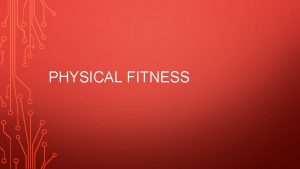WARREN CONSOLIDATED SCHOOLS HEALTH EDUCATION FITNESS UNIT Lesson












































































































- Slides: 108

WARREN CONSOLIDATED SCHOOLS HEALTH EDUCATION “FITNESS UNIT”

Lesson One Fitness For Life • Student Learning Targets (Objectives) – I will be able to define physical fitness, health, and wellness. – I will be able to describe some of the benefits of fitness, health & wellness.

Fitness For Life • Physical Fitness: – Is the ability of your body systems to work together efficiently to allow you to be healthy and effectively perform activities of daily living. – A fit person is able to perform schoolwork as well as responsibilities at home and still have enough energy to enjoy school sports or other activities. – Developing a personal plan for regular physical activity can help you keep your activity level high and avoid sedentary living. – Getting fit and staying fit can be fun when you choose activities

Fitness For Life • Developing a personal plan for regular physical activity can help you keep your activity level high and avoid sedentary living. • Getting fit and staying fit can be fun when you choose activities

Fitness For Life • Physical Activity: – Movement using the large muscles of the body. – This is a general term that includes: sports, dance, and activities done at home or work, such as walking, climbing stairs, or mowing the lawn.

Fitness For Life • Exercise: – Performing physical activity for the purpose of getting fit.

Fitness For Life Cycle of Physical Activity Benefits PHYSICAL ACTIVITY HEALTH AND WELLNESS PHYSICAL FITNESS • Being active provides you a double benefit: – 1. Improved physical fitness. – 2. Improved health & wellness. – The goal is to find ways to keep the cycle going throughout your life.

Fitness For Life • Benefits: – Keeps you healthy • Has a profound effect on preventing illness and disease. – Look good • Increase lean muscle and decrease body fat. – Feel good • Resist fatigue, decrease chance of injury, work more efficiently. – Enjoy life • Allows you to do fun things in life where some who are ill or not fit cannot do. – Meet emergencies • Allows you to be fit enough to meet emergencies and day to day demanding situations like running for help or changing a flat tire etc.

Lesson Two Fitness Through Physical Activity • Student Learning Targets (Objectives) – I will be able to name & describe the five parts of health related physical fitness. – I will be able to name & describe the six parts of skill-related fitness. – I will be able to explain how to use the stairway to lifetime fitness.

Fitness Through Physical Activity • Physical fitness is made up of 5 components: – Cardiovascular Fitness – Strength – Muscular Endurance – Flexibility – Body Composition

Fitness Through Physical Activity • Health-Related Physical Fitness – Cardiovascular Fitness • Ability to exercise your entire body for long periods of time without stopping. • Requires a strong heart, healthy lungs, and clear blood vessels to supply the cells of your body with oxygen they need.

Fitness Through Physical Activity • Health-Related Physical Fitness – Strength • The amount of force your muscles can produce. • Often measured by how much weight you can lift or how much resistance you can overcome. • Those with good strength can perform daily tasks efficiently with the least amount of effort.

Fitness Through Physical Activity • Health-Related Physical Fitness – Muscular Endurance • The ability to use your muscles (contract them) many times without tiring. • Those with good muscular endurance are likely to have better posture and fewer back problems.

Fitness Through Physical Activity • Health-Related Physical Fitness – Flexibility • The ability to use your joints fully through a wide range of motion. • You are flexible when your muscles are long enough to allow adequate movement.

Fitness Through Physical Activity • Health-Related Physical Fitness – Body Composition • The percentage of body weight that is made up of fat when compared to the other body tissues, such as bone & muscle. • People who are in a healthy range of body fat % are more likely to avoid illness and even have lower death rates.

How Much Physical Activity Is Enough? The Basic Principles of Physical Activity Can Be Applied the Components of Fitness – Principal of Overload • States that the only way to produce fitness and health benefits through physical activity is to require your body to do more than it normally does. • An increased demand on your body (overload) forces it to adapt. • The Story of Milo & His Bull.

How Much Physical Activity Is Enough? • Basic Principles of Physical Activity – Principal of Progression • States that the amount and intensity of your exercise should be increased gradually. • Threshold of Training – Is the minimum amount of overload you need to build physical fitness. Target Ceiling • Too Much Threshold of Training • Builds Fitness Inactivity • Not Enough

How Much Physical Activity Is Enough? • Basic Principles of Physical Activity – Principle of Specificity • States that the specific type of exercise you do determines the specific benefit you receive. • Example: Running will produce cardiovascular fitness but will not have an effect on building strength.

How Much Physical Activity Is Enough? • FITT Formula – Helps you apply the basic principles of exercise. Each letter represents an important factor for determining how much physical activity is enough.

How Much Physical Activity Is Enough? • FITT Formula – Frequency • Refers to how often you do physical activity. • For physical activity to be beneficial, you must do it several days a week. • FITT Formula – Intensity • Refers to how hard you perform physical activity. • Intensity is determined differently depending on the type of activity. • Cardiovascular fitness is measured by heart rate while strength is measured by the amount of weight you lift.

How Much Physical Activity Is Enough? • FITT Formula – Time • Refers to how long you do physical activity. • The length of time you should do physical activity depends on the type of activity you are doing and the part of fitness you want to develop. • To build cardiovascular fitness you need to exercise for 20 minutes or more. • FITT Formula – Type • Refers to the kind of activity you do to build a specific part of fitness or to gain a specific benefit. • One type of activity may be good for building one part of fitness but may not work to build another part of fitness.

Cardiovascular Fitness • Regular physical activity benefits two vital body systems: – Cardiovascular System • Made up of your heart, blood vessels, and your blood. – Respiratory System • Made up of your lungs and the air passages that bring oxygen from outside your body into your lungs.

Cardiovascular Fitness • Heart – Because your heart is a muscle it benefits from exercise. – Your heart acts like a pump to supply blood to your body cells. – When you do vigorous physical activity, your muscle cells need more oxygen and they produce more waste products.

Cardiovascular Fitness • Heart Rate – A person who does regular physical activity might have a resting heart rate of 55 -60 beats per minute. A unfit individual may be 70 or more beats. – A fit person’s heart works more efficiently by pumping more blood with fewer beats.

Cardiovascular Fitness • Blood – Cholesterol • A fatlike substance found in meats, dairy products and egg yolks can be dangerous if high levels build in your body. • Cholesterol is carried through the bloodstream by particles called lipoproteins. • Blood – Low Density Lipoproteins (LDL) • Is often referred to as bad cholesterol because it stays in the blood and contribute to clogged arteries. – High Density Lipoproteins (HDL) • Is the good cholesterol because they carry LDL’s out of the bloodstream for elimination.

Cardiovascular Fitness • Blood – An LDL lower than 100 is considered optimal for good health. – An HDL above 60 is considered optimal for good health. – Regular physical activity helps improve your cardiovascular fitness by reducing LDL levels and increasing HDL levels.

Cardiovascular Fitness Benefits of Physical Activity on the Cardiovascular System Heart Blood Vessels Blood • Heart muscle gets stronger • Pumps more blood with each beat • Beats slower • Works more efficiently • Healthy elastic arteries allow more blood flow • Less risk of clogged arteries (atherosclerosis) • Less risk of blood clot leading to heart attack • Less bad cholesterol (LDL) and other fats in the blood • More good cholesterol (HDL) in the blood

Effects of Exercise on the Heart

Cardiovascular Fitness • Aerobic Activity – Is a vigorous activity that elevates your heart rate high enough to build cardiovascular fitness.

Cardiovascular Fitness • How Much Cardiovascular Activity? – To create an “Overload” you must increase your heart rate with a vigorous aerobic activity. This will build good levels of cardiovascular fitness. Physical Activity Threshold and Target Zone Threshold of Training Target Zone Frequency 3 Days/Week 3 -6 Days/Week Intensity 65% of M. H. R. 65 -90% of M. H. R. Time 20 continuous 20 -60 minutes continuous minutes

Cardiovascular Fitness • How to Measure Intensity of Your Aerobic Activity – Target Heart Rate Lab

Cardiovascular Fitness • Anaerobic Physical Activity – Activity that is so intense that your body cannot supply adequate oxygen to sustain it for long periods of time. – For this reason it is done in short bursts and then rest periods. – Activities include: sprinting, swimming very fast & sports such as football.

Cardiovascular Fitness • Active Aerobics – Only those activities that are vigorous enough to elevate the heart rate above the heart rate threshold and into the target zone. – The aerobic activities listed are among the most popular activities because: • They often do not require a high level of skill. • The frequently are not competitive. • The often do not require a partner or a group. • Aerobic Dance – Low Impact, high impact, step • Aerobic Exercise Machines – Treadmills, stair steppers, exercise bikes, rowing machines, eliptical • Bicycling • Circuit Training • Dance – Modern, Ballet, Folk, Square, Waltz, Country , Hip-Hop and Line Dance • Martial Arts Exercise – Tae. Bo, Cardio Karate • Rope Jumping • Swimming • Water Aerobics

Flexibility • What is Flexibility? – Flexibility is the ability to move your joints through a full range of motion (ROM). – A joint is a place in the body where bones come together. – Common joints include: • Ankles, knees & hips in the leg region. • Knuckles, wrist, elbows, and shoulders in the arm region. – Range of Motion (ROM) • Is the amount of movement you can make in a joint.

Flexibility • Benefits of Good Flexibility – Improved Function • Everyone needs a minimum amount of flexibility to maintain health & mobility. • People will move better when they are flexible. • Benefits of Good Flexibility – Improved Health & Wellness • Stretching can help prevent injury and muscle soreness. • Stretching short muscles helps improve posture, which helps prevent or relieve back pain.

Flexibility • Characteristics of Flexibility – Body Build & Flexibility • Some people are more flexible than others, generally females tend to be more flexible than males. – Hypermobility • The ability to extend the knee, elbow, thumb, or wrist joint past a straight line, as if the joint could bend backwards. • Example: elbow joint locking when doing push ups. • Characteristics of Flexibility – Joint Laxity (Looseness) • Supporting tissue around a joint allows the bones to move in ways other than intended. • If laxity occurs in a knee joint, it may lead to knee sprains and torn cartilage or a dislocated kneecap. • Strengthening the muscles around the joint can help reduce joint laxity.

Flexibility • Balancing Strength & Flexibility – Everyone needs strong muscles, but only strength training can lead to a loss of normal range of motion. – On the other hand, if you only do flexibility exercises, then your joints may become susceptible to injury.

Flexibility • Fitness Principles and Flexibility – Principle of Overload • You need to stretch your muscles longer than normal to increase flexibility. • To achieve this, you usually need a force greater than your own opposing muscles. • You need additional force, such as your own body weight. • Example: – When you put your arms on either side of a doorframe and lean forward.

Flexibility • Fitness Principles and Flexibility – Principle of Progression • You need to gradually increase your flexibility exercise intensity. • You can increase intensity by stretching farther as you gain flexibility. • You may also progress by gradually increasing the amount of time you hold the stretch or the number of repetitions you perform.

Flexibility • Fitness Principles and Flexibility – Principle of Specificity • Flexibility exercises improve only the specific muscles at the specific joints that you stretch. • To develop overall flexibility, you must stretch all the muscles that need stretching. Muscle(s) Reason for Stretching Chest Muscles To prevent poor posture Front of Shoulders To prevent poor posture Front of Hip Joint To prevent swayback posture or backache Back of Thigh (Hamstrings) To prevent swayback posture or backache Inside of Thigh To prevent back, leg, and foot strain Calf Muscles To avoid Achilles Tendon injuries Lower Back To prevent back injuries

Flexibility • Types of Flexibility Exercises – Static Stretching • Stretching slowly as far as you can without pain, until you feel a sense of pulling tension. • The stretch should be held for a minimum of 30 seconds or more for best results.

Flexibility • Types of Flexibility Exercises – Active Static Stretching • Taking yourself through the stretch. – Passive Static Stretching • Having someone take you through the stretch.

Flexibility • Types of Flexibility Exercises – PNF Stretching (Proprioceptive Neuromuscular Facilitation) • Involves contracting the muscle before you stretch it so that you can stretch it farther. • Some variations require a partner assist you.

Flexibility • Types of Flexibility Exercises – Ballistic Stretching • A series of quick but gentle bouncing or bobbing motions that are not held for a long time. • Be careful, stretching too quickly or overstretching can cause injury.

Flexibility • Types of Flexibility Exercises – Dynamic Flexibility • active movements of muscle that bring forth a stretch but are not held in the end position. • When you put your body through a series of stretches while in motion, it sends signals from the brain to the muscle fibers and connective tissues in that area to prepare to do work. – Dynamic Flexibility • Raises the body’s temperature. • Increases blood flow to the working muscles. • Prepares those muscles for strenuous activity.

Dynamic Flexibility

Flexibility • Warm Up (Dynamic) – A warm up is a series of activities that prepares your body for more vigorous activity. • Improves Performance • Helps Prevent Injury • Cool Down (Stretching) – After a workout, your body needs to recover from the demands of physical activity. • Returns the body to a resting state (Homeostasis) • Helps reduce soreness

Body Composition • Body Composition – All the tissues that make up your body. – For a typical person, 15 to 25 % of the body composition is fat and 75 to 85 % is lean body tissue. – Lean body tissue includes: muscles, bones, skin and body organs such as the heart, liver, kidneys, and lungs.


Body Composition • Body Composition – People who do regular physical activity typically have a larger % of lean body weight, especially from muscle and bone. – Having a low % of body fat is desirable for good health.



Body Composition


Body Composition • Factors Influencing Body Fat % – Heredity • You inherit your body type from your parents. • Some people are born with a tendency to be lean, muscular or fat. • Inherited tendencies make keeping body fat levels in the good fitness zone easy for some but difficult for others.

Body Composition • Factors Influencing Body Fat % – Metabolism • Basal Metabolism Is the amount of energy your body uses just to keep you living. • This energy is measured in units called calories. Your basal metabolism does not include the calories you burn in work, recreation, studying, or even sitting and watching TV. – Metabolism • Some people have a higher basal metabolism than others, this means that their bodies, at complete rest, burn more calories than others. • Metabolism is affected by heredity, age, and maturation. • As you get older, your rate of metabolism slows down.

Body Composition • Factors Influencing Body Fat % – Maturation • As you grow older and the hormone levels in your body begin to change, levels of body fat also change. • During teen years, female hormones cause girls to develop higher levels of body fat than boys. • Males tend to have greater muscular development due to the hormone testosterone in the body.

Body Composition • Factors Influencing Body Fat % – Diet • The amount of energy in food is measured in calories. • A typical teenage male needs to consume about 2, 500 to 3, 000 calories a day to maintain an ideal level of body fat %. • A typical teenage female needs about 2, 000 to 2, 500 calories a day. • If one takes in too many calories, it may have an effect on body fat%.

Body Composition • Factors Influencing Body Fat % – Physical Activity • Your body burns calories for energy (Metabolism). • The more vigorous activity you do, the more energy your body uses and the more calories you need. • An inactive person uses less energy each day than an active person. • Being inactive may lead to a person not burning enough calories and therefore storing more body fat.

Body Composition • Body Fat: How Much Is Good? – Weight vs. Fat • Weight is not a good indicator of fitness and health. • Muscles weight more than fat. Thus, you can weigh more than someone else of the same size. • This is why body fat % is the best indicator of fitness and health.

Body Composition • Body Fat: How Much Is Good? – Overfat means having too much body fat. – Obesity is a term used to describe people who are overfat to a point where there are severe health risks. • Body Fat: How Much Is Good? – Females • Teenage girls should not have less than 11% or more than 25% body fat. • Over 35% is considered obese for females. – Males • Teenage boys should not have less than 6% or more than 20% body fat. • Over 30% is considered obese for males.

Body Composition • Overfatness, Obesity, Health & Wellness – Having too much fat can be unhealthy. – Scientists report that people who are overfat have a higher risk of: • Heart disease • High blood pressure • Diabetes • Cancer – Health costs for obese people are about $1, 500 a year more than for people with healthy body fat levels. • Overfatness, Obesity, Health & Wellness – In 2009, three out of every ten adults in Michigan were obese, while approximately 35% of adults were overweight. – In 2018, Michigan is expected to spend $12. 5 billion on obesity related health care costs if rates continue to increase at their current levels.

Body Composition • Body Fat Assessment – Skinfold Measurements • Measures the thickness of skinfolds, the fat under the skin. • A special instrument called a caliper is used to measure the skinfold thickness.

• Body Fat Assessment: Skin Caliper Test Video

Muscle Fitness • Muscular Endurance – Is the ability to contract muscles many times without tiring or to hold a muscle contraction for a long time. • Strength – Indicates the amount of force a muscle or muscle group can exert.

Muscle Fitness • Progressive Resistance Exercise – You gradually or progressively increase the amount of overload you apply to the muscles. – Both muscular endurance and strength are developed by this. • Resistance – Refers to a force that acts against your muscles. – It usually is measured in terms of pounds. – You can lift your own body weight, use free weights (barbells or dumbbells) or use weight machines.

Muscle Fitness • Strength & Endurance use resistance in different ways. – Strength is developed by doing an exercise for a short amount of times (1 -12 repetitions) but with a lot of resistance. – Muscular Endurance is developed by doing an exercise many times (13 -100 repetitions) but with less resistance. • Strength training tends to increase the size of the muscles as they become stronger. – Hypertrophy • Is the increase of the muscle size. • Endurance training does not cause as much hypertrophy

Muscle Fitness • Muscle Fitness Terminology – Repetitions (Reps) • The number of consecutive times you do an exercise. – Set • One group of repetitions – Positive Phase (Concentric) of Rep » Lifting the Weight – Negative (Eccentric) Phase of Rep » Lowering the Weight Exercise Repetitions Push Ups 10 Exercise Repetitions Push Ups (Set #1) 10 Push Ups (Set #2) 10 Push Ups (Set #3) 10

Muscle Fitness • Types of Muscle Contractions – Isotonic Contraction • A muscle contraction that pulls on the bones and produces movement of the body parts. – Concentric » Muscle Shortens – Eccentric » Muscle Lengthens • Types of Muscle Contractions – Isometric Contraction • Occurs when muscles contract and pull with equal force in opposite directions, so no movement can occur. – Example » Pushing your hands together

Muscle Fitness • Slow-Twitch Muscle Fibers – Contract at a slow rate and are usually red in color. • Fast-Twitch Muscle Fibers – Contract quickly and are white in color. • These fibers generate more force when they contract. • These fibers are important for strength activities. • These fibers generate less force than fast-twitch muscle fibers but they are able to resist fatigue. • Intermediate Muscle Fibers • Slow-twitch muscle fibers – Have characteristics of both slow are involved in and fast twitch fibers. cardiovascular activities – They contract quickly and have such as running for good endurance. distance. **The type of fibers in your muscles are determined by your genetics.

Muscle Fibers

Muscle Fitness • Types of Strength Training – Weight Training (Free Weights) • This form of exercise is done to improve muscular strength & endurance. • It usually involves using free weights such as barbells, dumbbells or body weight exercises.

Muscle Fitness • Types of Strength Training – Resistance Training (Machines) • This type of training is the same as weight training except that a machine that provides resistance is used rather than free weights.

Muscle Fitness • Benefits of Muscle Fitness – Increased muscle mass. – Decreased body fat. – Reduced injury. – Increased confidence.

Building Strength • Myths and Misconceptions – No Pain, No Gain • Some believe that exercise must hurt to see results. • If you feel pain, it is the body’s way of saying stop. • There is a difference between pain and discomfort.

Building Strength • Myths and Misconceptions – Body Dysmorphia • A term used to identify a condition that occurs when people become obsessed with building muscle. • This is an obsessivecompulsive disorder that often requires treatment by a professional. • Can lead to taking drugs or excessive use of supplements.

Muscle Dysmorphia

Building Strength • Myths and Misconceptions – Muscle Fitness for Females • Many think that only males should strength train. • Both males and females need strength to stay healthy. • The hormones in female bodies prevent them from developing large, bulky muscles.

Building Strength • Myths and Misconceptions – Muscle Imbalances • If only one side of the joint is trained, muscle imbalances will occur. • Example: performing bench presses but not any rows. • This type of imbalance can lead to injuries.

Building Strength • Fitness Principles & Strength – Principle of Overload • A muscle must contract harder than normal to become stronger. • Therefore you must expose your muscles to greater loads of weight. 135 lb Bench Press • Week 1 145 Lb Bench Press • Week 2

Building Strength • Fitness Principles & Strength – Principle of Progression • Overload gradually. – Increase the load over a period of time—to get the best improvement in muscle strength. – You can injure yourself if you try to lift too much weight too soon. 155 lb Bench Press 150 lb Bench Press 145 lb Bench Press 135 lb Bench Press

Building Strength • Fitness Principles & Strength – The Double Progressive System • 1 st Progression • You begin by performing a low number of reps in each set. • As you improve, you gradually increase the reps you perform in each set. • Fitness Principles & Strength – The Double Progressive System • 2 nd Progression – To build strength, you stop increasing reps when you reach 10. – You drop back to doing lower reps and increase the weight of the lift. – You typically will increase the weight by 5 -10 lbs.

Building Strength • Fitness Principles & Strength – Principle of Specificity • You must exercise the specific muscle groups you want to develop. – Example: to strengthen the hamstrings, you must perform leg curls or Stiff Leg Deadlifts.

WEIGHT ROOM LAB • Squat • https: //www. youtube. com /watch? v=o. GDWp. QBM 4 AU

WEIGHT ROOM LAB • PUSH & RING ROW • https: //www. youtu be. com/watch? v=J_ Bw. ZHz. TGY 0

Building Strength • Fitness Principles & Strength – Principle of Rest & Recovery • Indicates that you need to allow muscles time to rest and recover after a workout. • You should allow a minimum of 48 hours before training the same muscle(s) again. • Sleep is crucial for muscle recovery and growth after a workout.

Lesson Nine Types of Training Programs • Student Learning Targets (Objectives) – I will be able to describe a variety of methods of training to improve strength and/or muscular endurance. – I will be able to create a personalized strength training routine utilizing one or more of the methods discussed in the unit.

Types of Training Programs • Conventional Multiple Set – Each workout focused on a specific body part or group of body parts. – Each exercise, usually 2 -5 sets are completed. • Each set contains between 1 -12 reps. • Each set is taken to muscular fatigue not failure. • After each set, usually 30 sec to 2 min is taken to rest and recover. • Then the next set begins.

Types of Training Programs • High Intensity Training (Single Set) – System that requires the lifter to complete slow & controlled repetitions that requires 100% focus on a specific muscle group. – The concept of Momentary Muscular Failure (MMF) is used. • The point at which the targeted muscle or muscles fail on the positive phase, while performing controlled repetitions. – The lifter only completes (1) set because of the belief that exposing the muscle to MMF recruits all the muscle fibers needed in order for muscle growth. – This type of training is limited to mostly weight machine use because it is unsafe to take free weight to MMF.

High Intensity Training (Single Set) Video

Types of Training Programs • Manual Resistance Training – Manual resistance is a form of exercise that will allow you to have productive training sessions without having to rely on any equipment at all. When performed properly, manual resistance exercises can maximally stimulate improvements in muscular strength and endurance. Manual resistance will be the most intense style of training you have done if you are willing to push yourself to and beyond your limits.

Manual Resistance Training Video

Types of Training Programs • Stability Ball Training – The stability ball (also called an exercise ball, Swiss ball, or physioball) is a simple yet versatile piece of training equipment that you can use to train your whole body with fun and innovative moves. Stability ball training is effective in building balance, stability, and pillar strength.

Types of Training Programs • Stability Ball Training Benefits – Build pillar strength. Stability ball exercises are ideal for building pillar strength since they increase the demand of your shoulder, hip, and core stability. – Improve balance and coordination. The unstable surface of the stability ball forces your muscles to heighten their readiness. Your body will call more muscles into action to help stabilize your body and control that unstable surface. – Activate key muscles. Stability ball exercises can also help activate and elongate key muscles, much like you do in your Movement Prep routine. – Better sports performance. Stability ball movements create better body awareness. This can lead to a lower your risk of injury because you'll be less likely to turn an ankle or twist a knee when you're knocked off balance.

Stability Ball Training Video

Types of Training Programs • Resistance Band Training – The first benefit to using band exercises while working out is the fact that the equipment required is very inexpensive and portable. You may pack your exercise bands with you when travelling and work out wherever you happen to find yourself, including any hotel room.

Types of Training Programs • Resistance Band Training – The second major benefit relates to how effective band exercises are when starting to work out again following an injury, as part of a rehabilitation program. Band exercises have been used in such settings for a long time and are particularly effective at toning your muscles and allowing you to gradually increase the stress on your muscles as you regain more strength.

Resistance Band Training Video

Types of Training Programs • Body Weight Training – Bodyweight exercises are strength training exercises that do not require free weights; the practitioner's own weight provides the resistance for the movement. Movements such as the push-up, the pull-up, and the situp are some of the most common bodyweight exercises.

Types of Training Programs • Body Weight Training – In general, increasing the amount of repetitions will focus on improving endurance, while strength gains are made through increasing the intensity of the exercise through decreasing leverage and working at the ends of range of motion.

Body Weight Training Video

Types of Training Programs • P 90 X Training – Each workout is presented in a circuit format, in which you move from exercise to exercise with little rest in between, thus keeping your heart rate up. The p 90 X system requires you to work out 6 -7 days per week, with each workout lasting about 11½ hours.

FITNESS FOR LIFE “The Cross. Fit Way”

What is Cross. Fit? ? ? • Definition: – Constantly varied, high intensity, functional movement. – Cross. Fit is a training program that builds strength and conditioning through extremely varied and challenging workouts. – Each day the workout will test a different part of your functional strength or conditioning, not specializing in one particular thing, but rather with the goal of building a body that’s capable of practically anything and everything.

What is Cross. Fit? ? ? • Rather than having one workout for older women and another for hardcore athletes – there’s ONE workout each day that is completely scalable based on your skill. • For example, if the workout calls for squats with 135 pounds but you can only do squats with the bar (45 pounds), then that’s where you’ll start • Video: “Let me tell you about Cross. Fit”


What is Cross. Fit? ? ? • Cross. Fit Typical Workout – Dynamic warm up – not jogging on a treadmill for 5 minutes, but jumps, jumping jacks, jump rope, squats, push ups, lunges, pull ups. Functional movements, stretches, and mobility work that compliment the movements you’ll be doing in the workout that day. – Skill/Strength work: If it’s a strength day, then you’ll work on a pure strength movement (like squats or deadlifts). If it’s not a strength day, then you’ll work on a skill and try to improve, like one-legged squats, muscle ups or handstand push ups for example. – WOD: the workout of the day. This is where you’ll be told to do a certain number of reps of particular exercises as quickly as possible, or you’ll have a set time limit to do as many of a certain exercise as possible. – Cool down and stretching. Either as a group, or you’re allowed to stretch out on your own. This would also be the time for people who pushed too hard to go puke in a trash can and stretch their stomach muscles

What is Cross. Fit? ? ? **Close & Critical Article Reading*** “Understanding Cross. Fit”
 Normally consolidated and over consolidated soil
Normally consolidated and over consolidated soil What is skill-related fitness? *
What is skill-related fitness? * Jamie warren buffalo public schools
Jamie warren buffalo public schools Missouri consolidated health care plan
Missouri consolidated health care plan Unit 1 lesson 1 the importance of fitness
Unit 1 lesson 1 the importance of fitness Huntsville city schools powerschool
Huntsville city schools powerschool What is a target school
What is a target school Differences between health promotion and health education
Differences between health promotion and health education Health propaganda definition
Health propaganda definition Consolidated shipping services
Consolidated shipping services Consolidated global group
Consolidated global group Capital reserve meaning
Capital reserve meaning Gepa statement examples
Gepa statement examples Consolidated financial statements date of acquisition
Consolidated financial statements date of acquisition Ias 27
Ias 27 Shear eat
Shear eat Incomparent
Incomparent Consolidated companies are different sap
Consolidated companies are different sap Noc saga consolidated
Noc saga consolidated Consolidated service center
Consolidated service center People express airlines v consolidated rail corp
People express airlines v consolidated rail corp Abitibi consolidated
Abitibi consolidated Intercompany sap business one
Intercompany sap business one Consolidated business resources
Consolidated business resources Equity method vs cost method
Equity method vs cost method Prediction format
Prediction format Intercompany integration solution for sap business one
Intercompany integration solution for sap business one Unconsolidated undrained triaxial test mohr circle
Unconsolidated undrained triaxial test mohr circle Consolidated monitoring
Consolidated monitoring Crd consolidated
Crd consolidated Clinical document architecture
Clinical document architecture The floridan aquifer is consolidated.
The floridan aquifer is consolidated. Consolidated trust
Consolidated trust Consolidated financial statements and outside ownership
Consolidated financial statements and outside ownership Calaveras consolidated fire
Calaveras consolidated fire Consolidated business plan
Consolidated business plan What is an overall state of well-being or total health
What is an overall state of well-being or total health Unit 2 lesson 1 what is health
Unit 2 lesson 1 what is health Lesson 3 taking responsibility for your health
Lesson 3 taking responsibility for your health Unit 3 career exploration lesson 9 health science
Unit 3 career exploration lesson 9 health science Unit 2 lesson 3 health insurance and financial planning
Unit 2 lesson 3 health insurance and financial planning Unit 2 lesson 3 health insurance and financial planning
Unit 2 lesson 3 health insurance and financial planning Right triangle trigonometry examples
Right triangle trigonometry examples Health and fitness presentation
Health and fitness presentation Introduction of health and fitness
Introduction of health and fitness Exercise physiology for health, fitness, and performance
Exercise physiology for health, fitness, and performance Health fitness concepts
Health fitness concepts Components of health related fitness
Components of health related fitness Fitness chapter 6
Fitness chapter 6 Prohealth & fitness pt ot
Prohealth & fitness pt ot What is cardiovascular endurance in health related fitness
What is cardiovascular endurance in health related fitness Stairway to lifetime fitness health and wellness
Stairway to lifetime fitness health and wellness How to measure hexagon agility test
How to measure hexagon agility test Lifetime fitness augusta health
Lifetime fitness augusta health Vcert health and fitness
Vcert health and fitness Stairway to lifetime fitness health and wellness
Stairway to lifetime fitness health and wellness Agility meaning in mapeh
Agility meaning in mapeh Health and fitness: theory and practice
Health and fitness: theory and practice Ift model
Ift model Health fitness definition
Health fitness definition Health related physical fitness definition
Health related physical fitness definition Introduction of health and fitness
Introduction of health and fitness Health related fitness
Health related fitness Skill related
Skill related Components of health related fitness
Components of health related fitness Five for life
Five for life 5 health related fitness components
5 health related fitness components Three school of thoughts
Three school of thoughts Gilbert public schools special education
Gilbert public schools special education Chapter 12 lesson 4 fitness safety and avoiding injuries
Chapter 12 lesson 4 fitness safety and avoiding injuries Fitness for life chapter 3 review answers
Fitness for life chapter 3 review answers Lesson 3 components of fitness
Lesson 3 components of fitness Chapter 12 • lesson 1 benefits of physical activity
Chapter 12 • lesson 1 benefits of physical activity Unit 10, unit 10 review tests, unit 10 general test
Unit 10, unit 10 review tests, unit 10 general test Health promoting schools model
Health promoting schools model Mental health solutions in schools
Mental health solutions in schools Health framework for california public schools
Health framework for california public schools Unit 1 fitness
Unit 1 fitness Seated medicine ball throw test normative data
Seated medicine ball throw test normative data Unit2fitness
Unit2fitness Unit eleven fitness
Unit eleven fitness Unit 2 physiology of fitness
Unit 2 physiology of fitness Han feizi quotes
Han feizi quotes Hindleap warren bedrooms
Hindleap warren bedrooms Warren county ky jail commissary
Warren county ky jail commissary Visual cuts
Visual cuts Characters in the crucible
Characters in the crucible Marjory warren geriatria
Marjory warren geriatria Gigaplex academy
Gigaplex academy What is white model of communication
What is white model of communication Hindleap warren rooms
Hindleap warren rooms Warren bailey cornell
Warren bailey cornell Alwadiaah agency sdn bhd
Alwadiaah agency sdn bhd Demographic transition theory by warren thompson
Demographic transition theory by warren thompson Dawlish warren sea defences
Dawlish warren sea defences Quotes about elizabeth proctor
Quotes about elizabeth proctor Warren krug
Warren krug Dr warren selman
Dr warren selman What duty has mary warren been performing in salem
What duty has mary warren been performing in salem Warren mc
Warren mc Altxel
Altxel The power of context
The power of context Purpose of pathfinder club
Purpose of pathfinder club South warren high school
South warren high school Warren pryor poem meaning
Warren pryor poem meaning Warren pryor poem
Warren pryor poem Rick warren class 201 pdf
Rick warren class 201 pdf Indirect characterization quotes
Indirect characterization quotes Warren j ferguson
Warren j ferguson



